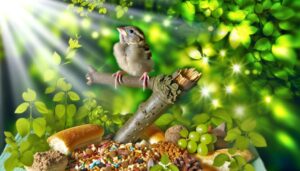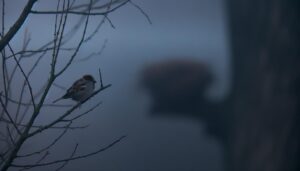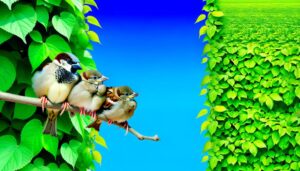How Do Sparrows Eat Baby Birds?
Yes, sparrows can eat baby birds, especially under extreme food scarcity. House Sparrows (Passer domesticus) are typically granivorous, consuming seeds, grains, and insects.
However, they may exhibit predatory behavior, invading nests and preying on nestlings when resources are limited. Sparrows have been observed engaging in cannibalism, targeting their offspring during dire conditions to survive.
This behavior underscores their ecological adaptability and survival strategies. While predation on baby birds isn't common, it does occur under specific environmental pressures.
Understanding these behaviors reveals much about sparrow ecology and survival tactics, shining light on broader ecosystem interactions.
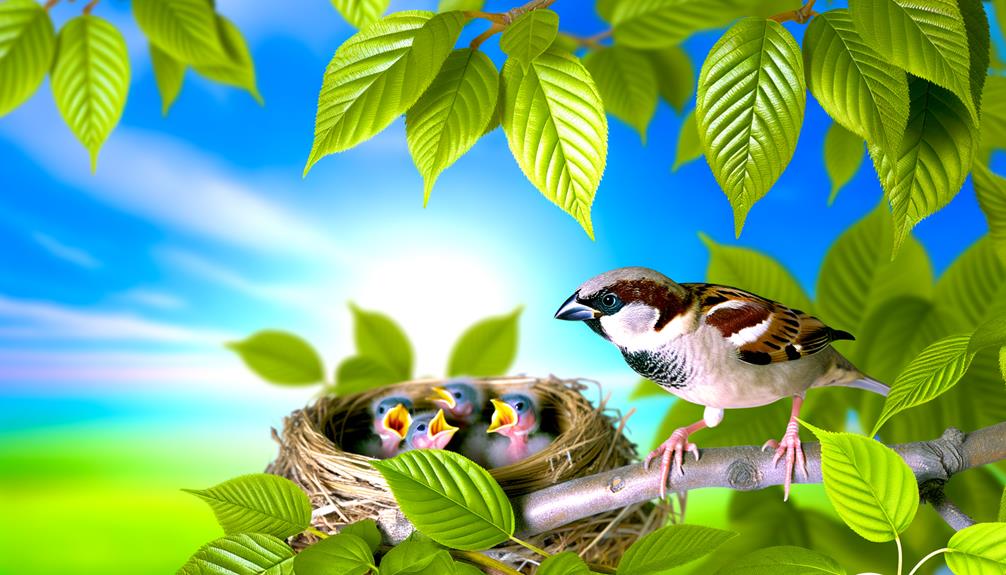
Key Takeaways
- Sparrows exhibit predatory behavior, targeting smaller birds and their nestlings under limited food resource conditions.
- Predatory actions include nest invasions and direct attacks on nestlings to reduce food competition.
- Cannibalism in sparrows occurs during extreme food scarcity or environmental stress.
- Sparrows consuming baby birds is typically a survival strategy during periods of significant resource shortage.
- This behavior provides immediate nutritional benefits, aiding sparrow survival and reproduction rates.
Sparrow Species Overview

Sparrows, particularly the House Sparrow (Passer domesticus), are small passerine birds recognized for their adaptability and widespread presence across various continents. You'll notice their compact bodies, short tails, and stout beaks, ideal for their omnivorous diet. Observing these birds, you'll find they thrive in both urban and rural environments, showcasing their remarkable ecological versatility.
Evidence indicates that their population density is highest in human-modified habitats, benefiting from proximity to food sources and nesting sites. For those aiming to support these creatures, understanding their social structure and breeding behaviors is crucial. House Sparrows exhibit strong territoriality and social bonds, often forming flocks that enhance their survival.
Typical Sparrow Diet
When examining a sparrow's diet, you'll find it primarily consists of seeds and grains, which provide essential nutrients.
They also consume insects and bugs, particularly during the breeding season to meet increased protein demands.
Additionally, sparrows incorporate fruits and berries into their diet, offering vitamins and moisture.
Seeds and Grains
You'll often find sparrows foraging for seeds and grains, which constitute the bulk of their natural diet. These birds exhibit a preference for specific types of seeds, and their foraging behavior is a proof of their adaptability and nutritional needs.
Detailed observations have shown that sparrows primarily consume:
- Grass Seeds – Common grasses like millet and wheat provide essential nutrients.
- Weed Seeds – Seeds from dandelions and chickweed are frequently targeted.
- Cultivated Grains – Corn, oats, and barley are also part of their diet, especially in agricultural areas.
Scientific studies underscore that these dietary choices are driven by the nutritional composition, availability, and seasonal variations of the seeds and grains. Understanding this behavior allows you to create supportive environments for sparrows, promoting their well-being and ecological balance.
Insects and Bugs
Insects and bugs form a significant portion of a sparrow's diet, especially during the breeding season when protein demands are high. You'll observe that sparrows consume a wide variety of arthropods to meet their nutritional needs. Studies show they often target soft-bodied insects because they're easier to digest and more nutrient-rich. For instance, caterpillars provide essential proteins and fats for growing chicks. Here's a detailed breakdown of common insects in a sparrow's diet:
| Insect Type | Nutritional Benefit | Commonly Consumed During |
|---|---|---|
| Caterpillars | High in protein and fat | Breeding season |
| Beetles | Rich in vitamins and iron | Year-round |
| Aphids | Source of carbohydrates | Spring and summer |
| Ants | Abundant amino acids | Summer |
Fruits and Berries
Sparrows often supplement their diet with a variety of fruits and berries, which provide essential vitamins and antioxidants important for their overall health. Observations indicate that sparrows frequently consume these nutritional sources, particularly during the breeding season when their energy requirements are heightened.
Here are three commonly observed fruits and berries in a sparrow's diet:
- Berries: Sparrows are known to eat small berries such as elderberries and blackberries, which are rich in antioxidants.
- Fruits: They often consume small pieces of fruits like apples and pears, providing essential sugars and vitamins.
- Seeds of Fruits: Sparrows also eat seeds from fruits, such as those found in grapes and cherries, which offer additional nutrients.
Nesting and Breeding Habits
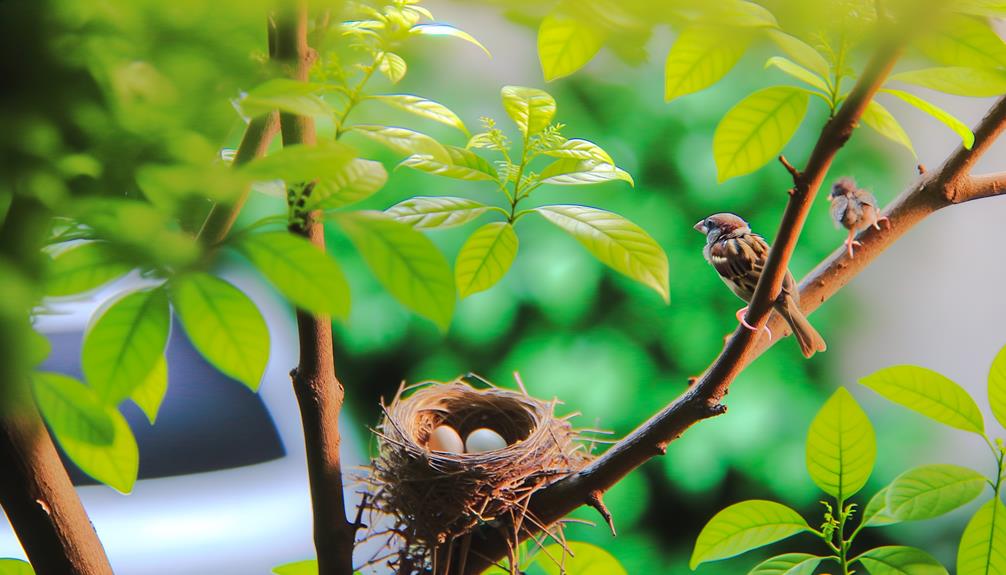
Understanding the nesting and breeding habits of sparrows requires examining their choice of nesting sites, clutch size, and parental care strategies. Sparrows typically select sheltered locations for their nests, such as eaves, dense foliage, or even man-made structures. They lay between 3 to 7 eggs per clutch, with an incubation period of around 11 to 14 days. Both parents actively participate in feeding and protecting the chicks until fledging occurs at about two weeks old.
| Aspect | Details |
|---|---|
| Nesting Sites | Sheltered, man-made, foliage |
| Clutch Size | 3-7 eggs |
| Parental Care | Both parents feed and protect |
Observed Predatory Behavior
Field observations reveal that certain sparrow species exhibit unexpected predatory behavior, occasionally targeting smaller birds and their nestlings. When you study these behaviors, you'll find they're more common in environments with limited food resources.
This predatory action includes:
- Nest Invasions: Sparrows may invade the nests of smaller birds, disrupting the breeding cycle.
- Direct Attacks: They sometimes attack and consume nestlings, a behavior noted in House Sparrows.
- Food Competition: By preying on other birds, sparrows reduce competition for available food.
These behaviors are believed to be survival strategies during periods of food scarcity. Detailed documentation and analysis have shown that these predatory actions, while not the norm, do occur under specific environmental pressures, offering insight into the adaptive behaviors of sparrows.
Cases of Cannibalism

In addition to predatory behavior, there are documented instances where sparrows exhibit cannibalistic tendencies, consuming their own species' nestlings under extreme conditions. Researchers have recorded such behavior primarily during periods of food scarcity or environmental stress.
For example, adult House Sparrows (Passer domesticus) have been observed preying on their offspring when alternative food sources are insufficient. This desperate survival strategy may serve to reduce the number of mouths to feed, ensuring that some offspring survive instead of none.
Observations confirm that cannibalism in sparrows is typically a last resort, triggered by dire circumstances. By understanding these behaviors, you're better equipped to address the root causes and promote more stable, balanced ecosystems where such extreme measures become unnecessary.
Comparisons With Other Birds
You should compare sparrows' dietary habits with other birds by examining their omnivorous tendencies.
Notice that while hawks display more predatory behavior, targeting small mammals and birds, sparrows primarily consume seeds and insects.
Dietary Habits Overview
When examining the dietary habits of sparrows, you'll find they mainly consume seeds and insects, which contrasts sharply with the more varied diets of other bird species like crows and hawks. Sparrows' diet is largely granivorous and insectivorous, focusing on readily available plant matter and small invertebrates.
In comparison, other birds exhibit more diverse feeding behaviors:
- Crows: Omnivorous, consuming fruits, small animals, carrion, and even human food waste.
- Hawks: Carnivorous, mainly preying on small mammals, other birds, and reptiles.
- Woodpeckers: Insectivorous, specializing in boring insects, larvae, and occasionally tree sap.
These differences highlight sparrows' niche adaptation, emphasizing their role in seed dispersal and insect population control, essential for ecological balance. Understanding these habits helps in creating effective conservation strategies.
Predatory Behavior Patterns
Sparrows exhibit minimal predatory behavior compared to birds like hawks and crows, whose diets consist mostly of other animals. You'll observe that sparrows primarily consume seeds, grains, and insects, demonstrating limited carnivorous tendencies.
Unlike hawks, which employ acute vision and powerful talons to capture prey, sparrows lack such adaptations. Crows, known for their intelligence, often scavenge and sometimes hunt smaller birds, showcasing significant predatory instincts.
Evidence suggests sparrow predation on baby birds is rare and opportunistic rather than a primary dietary behavior. Their beaks, adapted for seed consumption, further support this observation.
Understanding these distinctions helps you appreciate the varied ecological roles each bird species plays, fostering informed decisions in wildlife conservation and management.
Species-Specific Feeding Tendencies
Examining the feeding tendencies of sparrows in comparison to other birds reveals fascinating insights into their ecological roles and dietary preferences. Sparrows are mainly granivorous, consuming seeds and grains, but they also eat insects, especially during breeding seasons. Unlike some birds of prey, sparrows typically don't hunt other birds or their chicks.
Consider these comparisons:
- Hawks: Mainly carnivorous, hawks hunt smaller birds and mammals.
- Robins: Omnivorous, robins eat fruits, worms, and insects, showing more dietary variety.
- Blue Jays: Opportunistic feeders, blue jays consume nuts, fruits, and occasionally eggs or nestlings.
These differences underscore sparrows' role in seed dispersal and insect control rather than predation, emphasizing their contribution to balanced ecosystems.
Impact on Sparrow Population
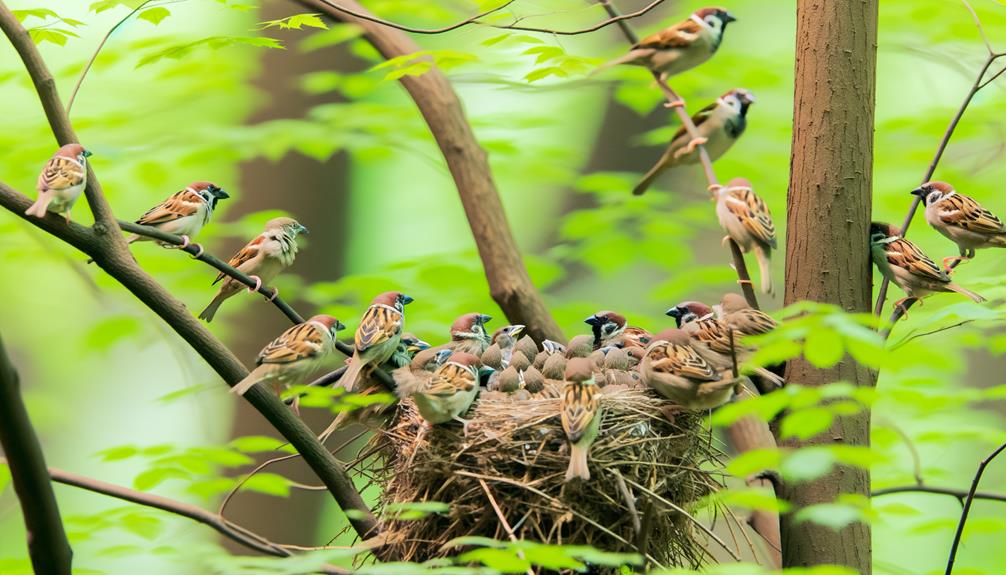
Understanding how sparrows' predatory behavior towards baby birds affects their population dynamics is crucial for conservation efforts. When sparrows prey on nestlings, they can inadvertently reduce the population of other bird species.
This predatory behavior might be associated with resource scarcity, compelling sparrows to seek alternative food sources. Studies have shown that increased predation on baby birds can lead to decreased biodiversity, disrupting local ecosystems.
For sparrows, consuming baby birds may offer immediate nutritional benefits, potentially boosting their survival and reproduction rates. However, this could lead to heightened competition among sparrows themselves.
Seasonal Diet Changes
You'll notice sparrows exhibit distinct seasonal diet changes, driven by resource availability.
During the spring and summer, they mainly consume insects, providing essential protein for breeding and rearing young.
Conversely, in autumn and winter, their diet shifts to seeds and grains, reflecting a scarcity of insect prey.
Insect Consumption Patterns
Sparrows display notable changes in their insect consumption patterns across different seasons, with a marked increase during the breeding period to meet the nutritional demands of their growing chicks. During this time, sparrows prioritize high-protein insects, which are essential for chick development.
To better understand these patterns, consider the following observations:
- Breeding Season: Sparrows hunt more actively for caterpillars, spiders, and beetles to provide sufficient protein and energy for their young.
- Post-Breeding Season: There's a gradual shift towards fewer insects as the chicks grow and the immediate demand for protein decreases.
- Winter Months: Insects are less available, so sparrows rely more on alternative food sources, reducing their insect consumption significantly.
These patterns ensure sparrows can effectively support their offspring and adapt to seasonal food availability.
Seed and Grain Preference
During the colder months, their diet shifts markedly towards seeds and grains due to the scarcity of insects. You'll notice sparrows frequenting bird feeders more often, consuming millet, sunflower seeds, and cracked corn.
Studies have shown that these avian species adapt their foraging behavior to maximize caloric intake during winter. Their beaks are well-suited for cracking open seeds, providing an efficient method to access essential nutrients.
Expert Opinions
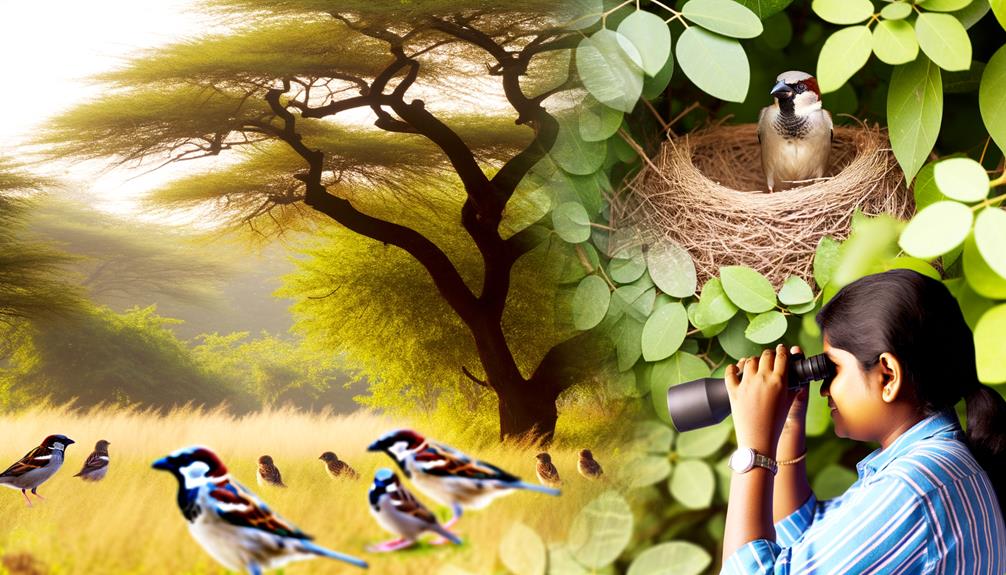
Consulting avian biologists provides essential insights into whether sparrows engage in the predation of baby birds. Experts in ornithology emphasize sparrows' typical diet mainly includes seeds and grains. However, they acknowledge occasional deviations.
Avian biologists highlight three important observations:
- Opportunistic Feeding: Sparrows may resort to eating insects or small animals, including baby birds, under extreme conditions such as food scarcity.
- Species-Specific Behavior: Certain sparrow species, like the House Sparrow, exhibit more aggressive tendencies, potentially leading to predation.
- Nest Competition: Sparrows sometimes destroy the nests of other birds, indirectly causing harm to baby birds, although not always for direct consumption.
Understanding these behaviors helps you better appreciate the complexities of sparrow feeding habits.
Research Studies and Findings
In examining peer-reviewed studies, you'll find that empirical evidence supports occasional instances of sparrows consuming baby birds, particularly under conditions of food scarcity. Researchers have documented House Sparrows (Passer domesticus) engaging in opportunistic predation. Detailed observations reveal that these events are rare and typically occur when natural food sources are depleted.
Studies using direct observation and video recording have identified sparrows attacking nestlings of other bird species, such as blue tits and house wrens. This behavior appears to be driven by nutritional stress. Data analysis shows that such predation isn't a primary food source but a supplementary one when insects and seeds are scarce.
These findings highlight the adaptive strategies sparrows employ to survive in challenging environments.
Implications for Birdwatchers

Birdwatchers should remain vigilant, as understanding sparrows' opportunistic predation on baby birds can greatly impact how you interpret and respond to avian interactions in the wild. Observing sparrows' behavior can provide critical insights.
Here are three actions you can take:
- Monitor Nesting Sites: Regularly check nests for signs of sparrow activity, such as damaged eggs or missing chicks.
- Document Interactions: Keep detailed records of sparrow interactions with other bird species, noting any predatory behavior.
- Report Findings: Share your observations with local birdwatching groups or conservation organizations to contribute to broader data sets.
Understanding these dynamics helps you protect vulnerable nests and contribute valuable data to ornithological studies, ultimately serving the avian community better.
Conservation Considerations
Considering sparrows' predatory behavior on baby birds, implementing targeted conservation strategies becomes vital to protect vulnerable avian populations. You should focus on habitat management, ensuring nesting sites are safeguarded from sparrow intrusion.
Utilize evidence-based measures such as installing sparrow-proof nest boxes and creating buffer zones. Monitoring and data collection play an essential role; document sparrow interactions and baby bird mortality rates meticulously.
Engage in community education initiatives to raise awareness about these conservation needs. By fostering collaboration with local birdwatching groups, you can amplify the impact of your efforts.
Leveraging scientific research, you'll be better equipped to devise adaptive strategies that mitigate predation risks and enhance the survival rates of at-risk bird species.
Conclusion
So, next time you're observing those adorable sparrows, remember they're not just seed munchers. They might be eyeing their neighbor's hatchlings for a protein-packed snack.
Yes, even birds have their dark side—cue the Hitchcock music. The evidence is clear: sparrows sometimes engage in cannibalism, and it's not just a fluke.
Be fascinated, be appalled, but above all, be informed. Birdwatching just got a lot more like a soap opera, didn't it?

